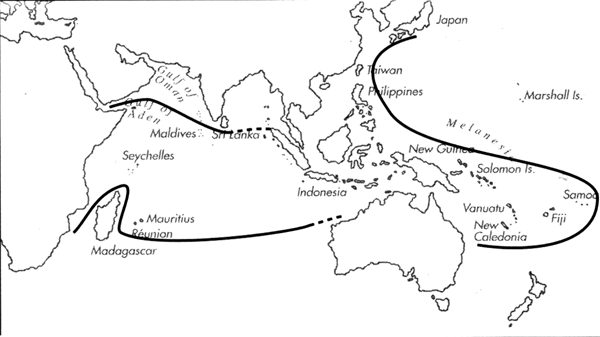Range: Indian Ocean: Mozambique to N. Somalia, Mascarenes, Maldives and Indonesia; Pacific: Japan to W. Australia and Queensland and to Fiji and Samoa.
Description: Small to medium-sized, moderately light to moderately solid; shells of form cernicus (Pl. 6, Figs. 29-31) smaller than shells of typical form. Last whorl conical or ventricosely conical to broadly conical or pyriform, narrower in form cernicus; outline slightly to distinctly convex adapically, less so, straight or somewhat concave below. Shoulder usually angulate, strongly to weakly tuberculate. Spire of low to moderate height, outline straight to concave. Larval shell of 1.7-2.0 whorls, maximum diameter about 0.7 mm. Postnuclear spire whorls tuberculate to faintly tuberculate. Teleoconch sutural ramps flat, with 1-2 increasing to 4-7 spiral grooves. Entire last whorl with closely spaced spiral ribs, weak in some populations.
| Shell Morphometry | ||
|---|---|---|
| L | 25-47 mm | |
| (typical form; 18-30 mm form cernicus) | ||
| RW | 0.09-0.30 g/mm | |
| ( typical form (L 23-35 mm); 0.05 - 0.14 g/mm (L 17-29 mm) form cernicus) | ||
| RD | 0.60-0.77 | |
| PMD | 0.78-0.90 | |
| RSH | 0.07-0.18 | |
Ground colour white, sometimes bluish violet. Last whorl encircled with a colour band, of various shades of brown to brownish red or olive, on each side of centre. Specimens with separate colour bands and ground-colour zones at centre, shoulder and base intergrade with specimens having only shoulder tubercles partially with ground colour. Dark zones of last whorl often speckled with white dots or dashes arranged in spiral rows, either scattered or regularly arrayed. Larval whorls and a few adjacent sutural ramps reddish violet. Later sutural ramps often of immaculate ground colour, sometimes maculated with markings matching spiral bands of last whorl in colour. Aperture translucent in small shells, violet to brown in larger shells.
Periostracum yellow-olive, thin, translucent, and smooth in shells from Japan, darker olive, thicker and opaque in shells from Somalia.
Foot dull red; sides may be mottled with black and sole may have scattered white dots. In the Indian Ocean, rostrum evenly reddish brown or dark brown with a pink tip. In specimens from Okinawa, rostrum pink, with white dots and dark brownish red transverse streaks longitudinally arrayed near tip; tentacles pale grey, mottled with white dots and short dark reddish brown streaks. In the Indian Ocean, siphon either dark brown with a pink tip or rose, heavily mottled with black dorsally. In Okinawa, siphon with a pink anterior and pale grey posterior portion, both dotted with white; pink portion additionally with dark brownish red transverse streaks (Kohn, unpubl. observ.).
Radular teeth matching those of C. varius (Nybakken, 1990).
Habitat and Habits: Typical form occurs intertidally and slightly subtidally on coral reef platforms, living on rough limestone, dead coral rocks, rubble and rubble mixed with sand, often hidden beneath coral rocks. Form cernicus from the Mascarenes and from Somalia is reported in 20-30 m (Cernohorsky, 1964; Kohn & Nybakken, 1975; Huish, 1978; Reichelt & Kohn, 1985; Loch, pers. comm., 1987). C. balteatus is known to feed on errant polychaetes (Kohn & Nybakken, 1975; Reichelt & Kohn, 1985). In the E. Indian Ocean, egg diameter of 310 ┬Ám predicts a minimum pelagic period of about 14 days (Perron & Kohn, 1985).
Discussion: C. balteatus is similar to C. rattus. For distinctions see the DISCUSSION of the latter species. C. lividus and C. sanguinolentus may be similar in shape, sculpture and colouration but typically attain larger size. Both differ in the spaced, weaker and usually granulose ribs around the last whorl, the apex is not reddish violet and the aperture is bluish to purple violet behind a orange-brown margin. Both have more larval whorls and a differently coloured animal. The intraspecific variability of C. balteatus has resulted in a number of synonyms that refer to individual variants or ecological forms. C. pigmentatus (Pl. 6, Fig. 35) is a typically patterned form with a tuberculate shoulder and the last whorl quite straight in outline. Such shells occur across the entire range of the species, although they are more common in eastern populations. C. p. concolor differs only in its violet colouration. C. tenuisulcatus Sowerby III, 1873, corresponds with the original figure of C. balteatus except for a slightly different colour pattern. C. moussoni (Pl. 6, Fig. 36) may represent a comparatively slender (RD 0.61) colour variant with a largely yellowish cream last whorl. The name C. cernicus applies to an ecological variant co-occurring with the typical form in the Mascarenes (Pl. 6, Figs. 29-31). Shells from this deep subtidal population closely resemble the original figure of C. circumclausus. If the high spire seen in the original figure of C. cernicus is considered to be somewhat aberrant, C. circumclausus can be synonymized with C. cernicus and hence with C. balteatus. Shells of this form differ only slightly from the typical form in their morphometry, less pronounced sculpture and often subangulate shoulder, and they intergrade in all characters with typical C. balteatus. A separation of the western and the eastern populations at the subspecies level (Coomans et al., 1982, 1983) is not justified, because the differences indicated by those authors are not geographically restricted.

C. balteatus Range Map
This section contains verbatim reproductions of the accounts of 316 species of Conus from the Indo-Pacific region, from Manual of the Living Conidae, by R÷ckel, Korn and Kohn (1995). They are reproduced with the kind permission of the present publisher, Conchbooks.
All plates and figures referred to in the text are also in R÷ckel, Korn & Kohn, 1995. Manual of the Living Conidae Vol. 1: Indo-Pacific Region.
The range maps have been modified so that each species account has it own map, rather than one map that showed the ranges of several species in the original work. This was necessary because each species account is on a separate page on the website and not confined to the order of accounts in the book.